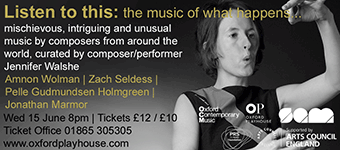June 15, 2011
Listen to this: The Music of What Happens was an interesting evening redefining our ideas and definitions of music. It consisted of four different pieces; Dead End, 124 Milton Street Extract, Plateau Pour Deux and Dog Star.
The first piece, Dead End, involved a single clarinettist and four mechanical moving toy cars. The whirring and lights on the toys distracted from the clarinet in a way which allowed the audience to choose where to focus their listening. It was difficult to ignore the flashing lights and movement of the toys (I’m sure that when I was a child, these things weren’t so sophisticated…) although once I closed my eyes I could focus on the eerie beauty of the clarinet rising through the distractions.
124 Milton Street Extract was based on the composer’s experiences in an old temperamental shower in New York. The piece required several musicians and was extremely serene. I enjoyed the sounds made by the use of glasses filled with water in juxtaposition to the drums in the background. It was easy to imagine a shower or other watery setting and I found it both peaceful and relaxing.
Plateaux Pour Deux involved a cello player and percussionist; the cello player seated on a platform moving across the stage and the percussionist made distracting noises (beeping a horn for example). It was similar to Dead End in that it was difficult to concentrate on only one noise at a time; I found myself anticipating the “Beep” whilst listening to the cello.
Dog Star was fascinating. It was aptly described by the curator of the show as “music from a parallel-universe” and uses similar techniques as some recognisable compositions but adds a twist. The music was alien yet inviting, I found parts of it very beautiful.
The evening challenged my ideas of what constitutes music and encouraged me to look for music more in my everyday life. Indeed even whilst I’m typing this, I’m thinking what a nice noise the keyboard makes and listening for sounds from the office next door…
The first piece, Dead End, involved a single clarinettist and four mechanical moving toy cars. The whirring and lights on the toys distracted from the clarinet in a way which allowed the audience to choose where to focus their listening. It was difficult to ignore the flashing lights and movement of the toys (I’m sure that when I was a child, these things weren’t so sophisticated…) although once I closed my eyes I could focus on the eerie beauty of the clarinet rising through the distractions.
124 Milton Street Extract was based on the composer’s experiences in an old temperamental shower in New York. The piece required several musicians and was extremely serene. I enjoyed the sounds made by the use of glasses filled with water in juxtaposition to the drums in the background. It was easy to imagine a shower or other watery setting and I found it both peaceful and relaxing.
Plateaux Pour Deux involved a cello player and percussionist; the cello player seated on a platform moving across the stage and the percussionist made distracting noises (beeping a horn for example). It was similar to Dead End in that it was difficult to concentrate on only one noise at a time; I found myself anticipating the “Beep” whilst listening to the cello.
Dog Star was fascinating. It was aptly described by the curator of the show as “music from a parallel-universe” and uses similar techniques as some recognisable compositions but adds a twist. The music was alien yet inviting, I found parts of it very beautiful.
The evening challenged my ideas of what constitutes music and encouraged me to look for music more in my everyday life. Indeed even whilst I’m typing this, I’m thinking what a nice noise the keyboard makes and listening for sounds from the office next door…




